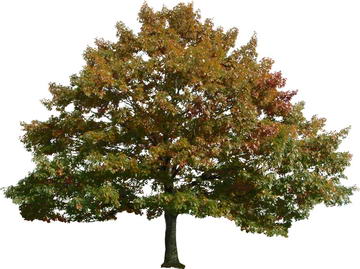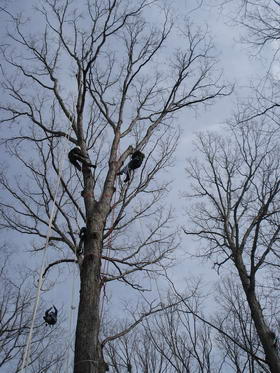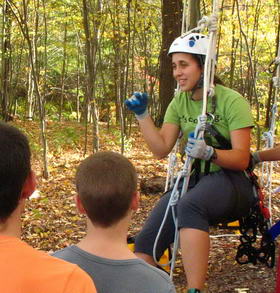First Steps for Starting an Adventure Tree Climbing Program:
- Look for a Climbing Tree

Open grown climbing tree Take a look around your site for possible climbing trees. Don't forget the possibility of a nearby park, camp, school or other partner site for running your tree climbing program.What to look for: The best climbing trees are "open grown", meaning that they didn't have other trees nearby as they grew, hence they have full canopies with many branches. Trees with lowermost branches that are near the ground and with many branches that extend well away from the trunk make the best climbing trees.
But you don't need a perfect, open grown tree in order to have a great climbing tree. Take a look at the forest grown tree on the left (one of the 3 Sisters), which has high first branches without much spread from the main trunk, but this is a very successful climbing tree.
Forest grown climbing tree Look for a tree that is large enough for fun climbs into the canopy and has a variety of branches for climbing rope stations. A rule of thumb is that branches need to be at least 3 inches in diameter to hold a climbing rope.Selecting your program tree: Once you have some candidates then we at Adventure Tree can help you narrow it down to your best choices. If we can arrange a visit then we'll walk around with you and help select the best tree or trees, or we can do that on the first day that we start implementing your program. You can jump-start the process by taking photos (include a person or object in the picture for a sense of scale) and then send them to us. We'll discuss your options with you and get ready for the process of preparing your tree for the climbing program. - Decide who will be your lead facilitator
 The lead facilitator oversees the tree climbing program and should be a responsible, competent person who is physically fit for climbing trees and running events. The lead facilitator will need to be on-site, geared-up and rescue-ready whenever there are participants climbing in the tree. He or she must be at least 21 years of age.Many programs operate with a single lead facilitator, but it may be helpful to have more than one lead for your program. You'll have more options for scheduling events and back-up help in case one of your lead facilitators needs to be absent for some reason.
The lead facilitator oversees the tree climbing program and should be a responsible, competent person who is physically fit for climbing trees and running events. The lead facilitator will need to be on-site, geared-up and rescue-ready whenever there are participants climbing in the tree. He or she must be at least 21 years of age.Many programs operate with a single lead facilitator, but it may be helpful to have more than one lead for your program. You'll have more options for scheduling events and back-up help in case one of your lead facilitators needs to be absent for some reason. - Contact us at Adventure Tree for consultation and scheduling
Any questions about how to get started or what's next? Please contact us via email or phone and we'll help you get going.We can advise on how many climbing rope stations you may need and the size of your program, how you can obtain insurance for your tree climbing program, how safe is tree climbing and what safety protocols we use, etc. We can provide information for presentations to board members and decision makers, photos and other materials for fund raising, references to other clients with whom we've worked, whatever you may need to get your tree climbing program off the ground.When you're ready, we can discuss when we're available and then schedule a visit to your location to prepare your climbing tree and train your facilitators. Approximately a week's dedicated effort and your tree climbing program will be up and running and you'll have excited, happy climbers wanting to come back for more.
Contact Us for help with any of these steps or to discuss getting your Adventure Tree Climbing program started. We're very much looking forward to hearing from you.